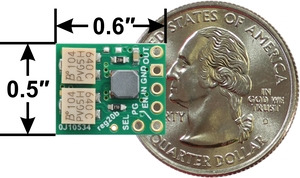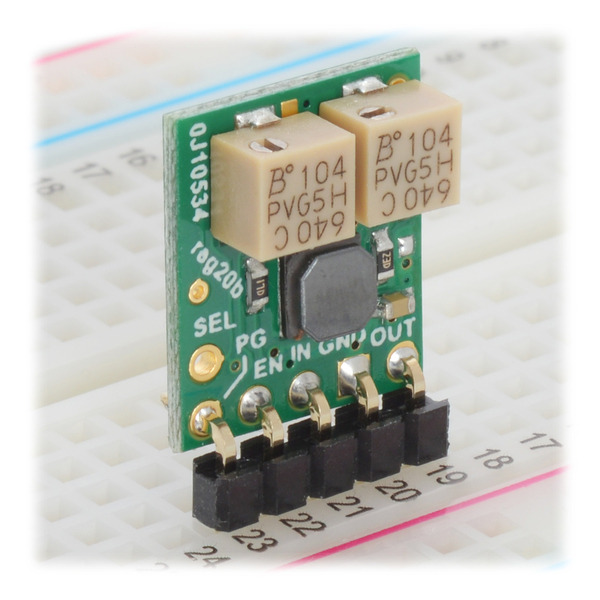Pololu Blog » Engage Your Brain »
New adjustable voltage regulators with multi-turn fine adjustment
 |
I am excited to announce our first voltage regulators with multi-turn trimmer potentiometers! I have wanted to add multi-turn pots to our products for a long time, but the problem has been that they are really expensive. They also tend to be quite big, at least compared to many of our boards, which we try to keep compact, and the smaller, surface-mounted ones are especially expensive. My latest round of looking for lower-cost options did not pan out, but I decided to just give it a try with the expensive parts.
The new S9V11x regulators that feature these potentiometers are buck-boost regulators that can output a voltage that is lower, the same, or higher than the input voltage. There are also versions with a multi-turn pot for adjusting the undervoltage cutoff threshold, so that if you use these with batteries, you can prevent overdischarging them. With twelve turns of adjustment available, it’s much easier to precisely set the voltages on the modules than with the single-turn potentiometers we have used on other adjustable regulators.
 |
The output and cutoff multi-turn adjustment potentiometers on the S9V11x voltage regulators. |
|---|
While I have been talking mostly about the potentiometers, the main regulator is pretty magical, too, giving you quite a bit of power over a broad operating input range in a small size.
 |
Typical maximum continuous output current of Step-Up/Step-Down Voltage Regulator S9V11x |
|---|
Our stock products are available in several combinations of adjustable and fixed output voltage and cutoff. If you have a higher-volume application, we can make them with fixed voltages wherever you need them. You could initially prototype your design with the adjustable version and then get fixed ones made once you know exactly what voltage you need.
| Regulator | Input (V) | Output (V) | Low-voltage cutoff | Size | Price | |
|---|---|---|---|---|---|---|
 |
#2868 S9V11MACMA | 2* – 16 | 2.5 – 9 (fine-adjust) | fine-adjust | 0.50″ × 0.60″ × 0.25″ | $19.95 |
 |
#2869 S9V11MA | 2.5 – 9 (fine-adjust) | – | $14.95 | ||
 |
#2870 S9V11F5S6CMA | 5 (6 V selectable) | fine-adjust | $14.95 | ||
| #2871 S9V11F3S5CMA | 3.3 (5 V selectable) | fine-adjust | $14.95 | |||
 |
#2872 S9V11F3S5 | 3.3 (5 V selectable) | – | 0.50″ × 0.60″ × 0.17″ | $10.95 | |
| #2873 S9V11F3S5C3 | 3.3 (5 V selectable) | 3 V (fixed) | $10.95 | |||
 |
#2836 S9V11F5 | 5 | – | 0.30″ × 0.45″ × 0.17″ | $11.95 | |
| * The regulator has a minimum start-up voltage of 3 V, but it can operate down to 2 V after startup. It is disabled when the input voltage is below the low-voltage cutoff. | ||||||
I am very interested to see what people think of the multi-turn adjustment feature. If these new regulators sell decently or customers ask for it, we will add the multi-turn potentiometers to our other regulator offerings. Is the extra expense worth it? Or do you know of a good, low-cost, multi-turn potentiometer we could consider for future products like this?
15 comments
- Jan
Thanks for your feedback! Adding a low voltage indicator LED and circuit would add to the current draw and size of the board, so I am not sure the trade offs would be worth it for a general-purpose regulator, but we will keep it in mind. You could also add a circuit like that externally to the regulator's VIN or EN pins. If you have a high-volume application for such a regulator, please let us know, and we can probably make it for you.
-Claire
Is it a problem if there's 5v applied on the output pin? From another power source? Is there a diode on the output pin? I tried googling, but haven't found the answer.
Thanks!
Costyn.
You definitely should never connect the output of this regulator to another source when the regulator is on. The board does not include any protection from power flowing back into the regulator, and in generally two regulated power sources will likely fight each other if directly connected. If you need to do something like that, I recommend looking into ORing circuits.
-Claire
Thanks for the response. I definitely won't be applying 5v to the output pin when the regulator is itself live. Just when I'm programming the attached microcontroller there'll be power on the 5v rail. When my project is installed it will be just the microcontroller.
Regards.
We do not disclose the regulator chip on those boards, but the soft start time is typically 850μs while boosting and 400μs while bucking. For information about other specific parameters please email us.
-Tony
I'd like to know some details about the low-voltage-cutoff function:
-how do you reset it? (I guess removing input voltage and putting in back on resets it, which would be just what I want)
-if the battery voltage goes above a certain level, will the regulator switched on again automatically?
Best regards,
Simon
Please refer to the "Setting the cutoff voltage" section of the product page, which answers both of your questions.
- Patrick
Yes, a switch can be used to ground the EN line and put the regulator in low-power sleep mode. It is fine to adjust the output of the regulator while it is on. I am not sure I understand your question about offering an external potentiometer. You could remove and replace the on-board potentiometer. If the replacement potentiometer is not soldered directly to the board, I recommend keeping the connections as short as possible to minimize any issues.
-Claire
is it possible to use 5v fixed stepdown (#2870) in car?
It's BEV with DC-DC to 12V. No alternator / ICE starting rubbish...
Best regards
kolaCZek
We would not recommend this for your application since we have many strictly step-down regulators that have a higher maximum input voltage, which would give you more margin on the high side. However, if your 12V source is actually clean and sure to stay under the 16V maximum input of the S9V11F5S6CMA regulator, you'll probably be fine. You might want to put an electrolytic cap on the input to prevent or limit any LC spikes on power-up that could go over 16V.
-Claire












